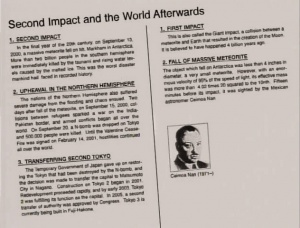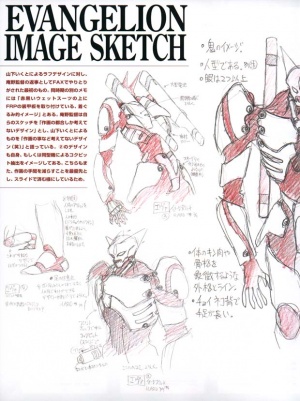Theory and Analysis:List of Common Misconceptions
A tentative list.
NGE is religious propaganda
The religious symbolism in NGE is actually not used in any sort of meaningful fashion. According to Evangelion Assistant Director Kazuya Tsurumaki:
"There are a lot of giant robot shows in Japan, and we did want our story to have a religious theme to help distinguish us. Because Christianity is an uncommon religion in Japan we thought it would be mysterious. None of the staff who worked on Eva are Christians. There is no actual Christian meaning to the show, we just thought the visual symbols of Christianity look cool. If we had known the show would get distributed in the US and Europe we might have rethought that choice"
LCL means "Link Connect Liquid"
It is unknown what the initials "LCL" stand for, but we do know what they don't mean. According to the Death and Rebirth theatrical program (special edition):
Incidentally, the widely circulated idea that L.C.L is the abbreviation of "Link Connected Liquid" is incorrect.
Nowhere does it say what it does mean. Evangelion Chronicle suggests that one of the Ls stands for "Lilith".
First Impact killed dinosaurs
First Impact was never depicted or directly referred to on-screen. This has led several fans upon first glance to incorrectly assume that because the "Second Impact" was supposedly a meteorite collision, the "First Impact" was thus the more well known asteroid impact with caused the mass-extinction of the dinosaurs at the end of the Cretaceous period, 65 million years ago.

However, First Impact (aka "Giant Impact") was actually the collision of a giant spherical object, designated the "Black Moon", into Earth approximately 4 billion years ago. As a result of the impact, huge amounts of debris, including the Black Moon's rocky exterior, were thrown into orbit, eventually coalescing into Earth's satellite, the Moon. The "meteorite" theory in the above textbook page is a cover story, and is part of the effort to also blame Second Impact on a meteor.
"Barons of Hell"
Almost from the beginning of Eva fandom, there has been an internet rumor that the Evangelions are based upon Biblical entities called "The Barons of Hell". There are two problems with this theory:
One is that there is no such thing as a "Baron of Hell" mentioned in the Bible or in any other Judeo-Christian source; extensive searches for the term have turned up only references to Eva and the Doom game. Some sources claim that the Barons are the same thing as the "Four Horsemen of the Apocalypse", but the descriptions given to the Barons don't match up to the Horsemen.
The other problem is that we know exactly what the Evangelions are based upon. Evas were fundamentally based upon the oni (commonly translated as “demon” or “ogre”, but actually a specific type of Japanese monster). Says Anno himself (in an interview published in Aerial Magazine):
There's a monster in Japan called the Oni; it has two horns sticking out of its head and the overall image of the Eva is based on that. I also wanted to give the impression that beneath this ‘robot monster’ image is not so much a robot, but a giant human.

An early sketch Anno did of an Eva clearly betrays their oni roots. Working from this basic premise, and corresponding with Anno along the way, Ikuto Yamashita developed the Evas as we know them (with the exception of EoE's “harpies”).
Only 14-year-olds can pilot Evas
Kids born after 2I are soulless
Spear of Longinus is the actual holy relic (that just somehow got BIG)
This is a product of puting too much stock in NGE's religious references. The Spear was actually excavated in Antarctica along with Adam, who was found impaled upon it. According to the Classified Information, each Source of Life is accompanied by a Spear that has a will of its own and can immobilize a Seed for going against its mission. Thus, the Spear of Longinus is billions of years old, not made by some Roman blacksmith, and impaled Adam for commiting some unspecified offense.
A.T. Field is a real-life psychology term
Since the very earliest days of Evangelion analysis, there has been a rumor that A.T. Field is a genuine psychological term that describes the barrier that seperates autism patients from the world around them. However, extensive searching of online Psychology researches and forums has failed to find any use of the term other than in reference to NGE. Therefore, we have concluded that this rumor is false.
Eva-00 has the soul of Naoko
Misato had no sexual interest in Shinji whatsoever
Shinji had absolutely no real interest in Asuka, or vice versa
Someone we know killed Kaji
Many fans have come to the conclusion that Misato shot Kaj, with little or no evidence to back it up. On the other hand, series creator Hideaki Anno has stated on the record that Kaji was not shot by any named character, but by an agent sent by either "Seele or Nerv's intelligence division." In fact, Anno was so shocked by this notion that in the Director's cut of Episode 21, he removed a shot that had been cited as "evidence" of Misato's guilt. As broadcast, the scene of Kaji being shot was followed by an establishing shot of the door to Misato's apartment with her name on it; this shot was replaced in the Director's cut by one of the outside of her apartment building.
Rei and Kaworu are actual albinos
The Super Solenoid is exactly the same thing as the Core
The Super Solenoid has nothing to do with the Core
Toji not only loses his leg, but his arm as well
Naoko's brain in Magi (or any other human brain for that matter)
Naoko's soul in Magi
Keel is the Wandering Jew
The Dummy Plug Plant is the Chamber of Guf
Adam was impaled on the Spear of Longinus by Lilith
Movie specific:
Death's string quartet scenes take place in the actual series timeline.
This one is easily disproved. Both Asuka and Kaworu appear in the String Quartet sequences. In the actual series timeline, Asuka is in the hospital under heavy sedation when Kaworu arrives, and is still there when he gets squished; they never meet. The String Quartet motif serves to separate the different focuses in Death as well as fitting together with the musical score that was used, Pachelbel's Canon in D major.
